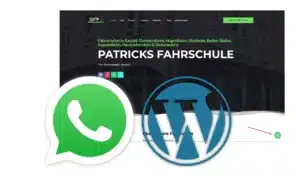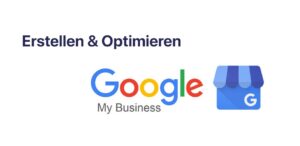Contents of the post
Introduction to SEO – Definition & Benefits
Visibility is crucial to the success of any website. But how do you achieve a prominent placement in search engine results?
The answer lies in the art of search engine optimization (SEO) and in particular in the creation of SEO-optimized content. This article serves as a comprehensive guide to teach you the key techniques and strategies you can use to create content that not only ranks, but also engages and retains your audience.
This guide has been carefully prepared by Lucas, an SEO freelancer created. The content was created based on several years of experience in the field of SEO.
What is search engine optimization (SEO optimized content)?
SEO is not just a phrase but a necessary practice in the world of digital marketing.
By optimizing your content for search engines, you increase the likelihood that your target audience will notice your website. But SEO-optimized content goes beyond simply integrating keywords. SEO is a comprehensive approach that takes into account the structure of your content, the user experience, and the technical aspects of your website.
This guide shows the most important aspects of SEO content creation: from keyword research, to structuring your content, to optimization for an improved user experience. We'll show you how to create content that is not only optimized for search engines, but also provides value and solutions for your readers. Whether you're a blogger, a content manager, or a business owner, the following strategies will help you strengthen your online presence and get your content to the top of search results.
Effective SEO-optimized content begins with a deep understanding of its meaning. Search engine optimization, or SEO, is the art and science of designing web content so that it is easily found and ranked higher by search engines.
Competitive Advantage: Visibility
First and most importantly, SEO increases the visibility of your content in search results. When potential customers search for information, products, or services that you offer, you want your website to appear prominently. Ranking high in search results leads to more clicks, traffic and ultimately conversions (sales). SEO-optimized content is your ticket to standing out from the crowd and attracting the attention of your target audience.
Building credibility / trust
Search engines like Google and Bing use complex algorithmic systems to evaluate the relevance and quality of websites.
Websites that appear at the top of search results are generally viewed by users as more trustworthy and credible.
By optimizing your content, you signal how to search engines Google or Bingthat your content is valuable and relevant, which strengthens your reputation among your target group.
Improved user experience
SEO goes hand in hand with improving user experience. Search engines prefer websites that load quickly, are mobile-friendly, and offer valuable content. By optimizing your content for SEO, you also improve the usability of your website. This not only leads to better ranking positions, but also higher satisfaction among your visitors.

- Google Hummingbird (2013): The update improved the search engine's ability to understand complex search queries by better interpreting the intent and context behind the queries.
- Mobile-First Indexing (2018): This update prioritized mobile-friendly websites for an improved user experience, as the majority of users were browsing the web via mobile devices at the time. Google responded to the trend and ensured that content was accessible and user-friendly on mobile devices.
- Page Experience (2020): By considering various factors such as mobile usability, core web vitals, security and HTTPS usage, this update evaluated the user experience on websites. It prioritized faster loading times and secure websites to provide a better browsing experience.
- Helpful Content (2022): This update was introduced to reward sites with user-friendly content and penalize those that primarily optimized content for search engines. The goal was to ensure that all content in search results pages answered a question and actually helped the user.
These updates make it clear that Google cares about putting the needs of its users first.
Therefore: Websites that are user-friendly appear more often in search results.
Long-term success
While paid advertising can deliver immediate results, SEO-optimized content offers a long-term benefit. Through continuous optimization and creating high-quality content, you can build a sustainable online presence. This organic approach is cost-effective and results in a steady increase in traffic and engagement.
Targeted traffic
By using relevant keywords and creating content that addresses your audience's needs and questions, you will attract qualified traffic to your website. This means your website visitors already have an interest in your products, services or information, increasing the likelihood of conversions.
SEO-optimized content is more than just a tool for better rankings; it is a strategy to maximize your online presence, build trust and establish a lasting relationship with your target audience. In the following sections, we'll take a detailed look at the techniques and best practices you can use to optimize your content for search engines and users.
Keyword research and application
A successful SEO strategy starts with proper keyword research. Keywords are the “building blocks of SEO-optimized content”.
They are the terms and phrases that your target audience enters into search engines to find information, products or services.
Effective keyword research and application not only helps you rank better in search results, but also increases the relevance of your content to the needs of your target audience.
Analyze target group
Before you start searching for keywords: Analyze your website's target audience:
- What questions do your visitors have? Answer this.
- What problems are your visitors trying to solve? Solve them.
- What kind of language do they use?
A deep understanding of your audience allows you to identify more relevant and targeted keywords.
Keyword research
There are many keyword research tools, both free and paid, such as:
Such tools provide valuable insights into search volume, competition and similar search queries.
They can be used to find keywords that can drive traffic to your website.
Long-tail keywords
Long-tail keywords are longer, more specific search phrases that often consist of three or more words.
Example: Let's say you run a website that sells handmade ceramics. A general keyword could be “ceramics,” which is very competitive and covers a broad search intent. A long-tail keyword for this could be: “buy handmade ceramic coffee cups”.
These keywords are typically less competitive than more general, shorter keywords. They are particularly valuable because they make it possible to respond more specifically to users' search intentions. People who use long-tail keywords are often further along in the purchasing decision process, meaning they are more willing to take an action like making a purchase or signing up for a service.
Naturally integrate keywords into content
Once you've chosen your target keywords, it's time to incorporate them into your content. It is therefore important that the keywords appear naturally in the text and do not disrupt the flow of reading. They should be used in headings, subheadings, the intro, conclusion and body text, but avoid keyword stuffing as this is perceived negatively by both search engines and readers.
Measure and adjust
SEO is a continuous process. Therefore, you should monitor the performance of the keywords in terms of rankings, traffic and conversions and adjust if necessary. Understanding which keywords are successful and which are not makes it possible to optimize content and SEO strategy for better results.
Proper selection and application of keywords is a critical step on the path to SEO success.
Creation and structuring of SEO content
Headings, paragraphs and metadata
One structured and well-organized content design is essential for search engine optimization. Search engines like Google prefer content that is clearly structured and offers users a good reading experience. This section highlights how the targeted use of headings, paragraphs and metadata can take your SEO content to the next level.
The importance of headings

Headings play a dual role in SEO optimization:
- On the one hand, they help search engines understand the structure and content of your site.
- On the other hand, they improve readability by providing readers with a clear overview of the content.
Use the H1 tag for the title of your content and break the text into smaller sections with H2 and H3 tags to identify topics and subtopics (see graphic above).
Paragraphs and readability
The way you format your paragraphs also has a huge impact on SEO and user experience. Long, confusing blocks of text can be off-putting and turn off readers and search engines. Short, concise paragraphs, packed with relevant keywords, on the other hand, promote readability and hold the attention of your target audience.
Use of metadata
Metadata, especially the title tag and meta description, are crucial to your page's ranking and click-through rate. The title tag defines the title of a document and is the first thing users see in search results. The meta description provides a brief overview of the content of the page. Both should be precise, descriptive, and key keyword-rich to appeal to both search engines and potential visitors.
Optimizing user experience and readability
How to write content that is optimized for both readers and search engines
Optimizing content for user experience (UX) and readability is crucial to meeting both your audience's needs and search engine requirements. Engaging, readable content engages readers, reduces bounce rates, and increases dwell time - important factors that search engines consider when assessing the quality of your website. Here are key strategies to optimize your content for optimal user experience and readability:
Short paragraphs and clear structure

Long blocks of text can be off-putting. Therefore, use short paragraphs and a clear structure to make your content clear and easy to digest.
Divide the text into sections with meaningful headings and subheadingsto make it easier for readers to navigate and highlight important information.
Understandable language and tone

Adapt the language and tone of your content to your target group.
Avoid jargon unless your audience is familiar with it.
Simple, clear language helps reach a wider audience and ensure your message is understood.
Use of lists and bullet points

Lists and bullet points are effective tools for presenting information clearly and concisely. They help draw readers' attention to important points and improve readability by visually breaking up the text.
Visual elements to support the text

Images, graphics and videos can help to make complex information understandable and break up the text.
Note: Visual elements should be relevant and use alt text to improve accessibility and SEO.
Mobile friendliness

Around 70% of users on the web use a smartphone
Making your website mobile-friendly is essential as more and more users access content via mobile devices. Make sure your content is easy to read on small screens and interactive elements are easy to use.

Almost all young and middle-aged adults in Germany have a smartphone. Over 95 percent of people between the ages of 14 and 49 have one. Smartphones are not just phones, but also devices with many functions. Many people between the ages of 50 and 59 (93 percent) also have smartphones. Of people between 60 and 69 years old, around 85 percent have a smartphone. And even among those over 70, 68 percent still have a smartphone. Source: Statista
Internal links

Use internal links to direct readers to related content on your website. Not only does this encourage visitors to stay on your website, but it also strengthens SEO by improving website structure and distributing link juice.
Ease of use and easy readability not only create valuable and engaging content, but also improve SEO performance.
A satisfied visitor is more likely to convert, share your content and return as a loyal customer.
SEO tools & feedback for continuous improvement
SEO (Search Engine Optimization) is dynamic and constantly changing. Therefore: It is a process that is ongoing.
New algorithm updates, changing user behavior and the evolution of digital technologies mean that what works today may be outdated tomorrow. Therefore, it is important to regularly analyze the performance of your content and make adjustments.
The importance of content analysis
To measure the success of your SEO efforts, you need to track key metrics such as:
- page views,
- length of stay,
- bounce rate,
- Conversion rate
monitor. Tools like Google Analytics and Google Search Console provide deep insights into your website's performance and help you identify areas for improvement.
Use feedback
In addition to quantitative data, qualitative feedback is invaluable. User comments, social media and customer surveys can give you direct feedback on how your content is perceived. This feedback can provide insight into what content resonates and where adjustments are needed.
SEO tools to help

There are some SEO tools that can help you optimize your content. Tools like SEMrush, Ahrefs and Moz offer features for keyword research, backlink analysis and content auditing. These tools can help you refine your SEO strategy and achieve better results.
We use SEMrush to optimize websites.
Evaluate & make adjustments
Based on the analysis and feedback you receive, you should be ready to make adjustments to your content. This could include updating keywords, improving user experience, or updating outdated information. Taking a proactive approach to adapting and improving your content is crucial for long-term SEO success.
Continuous learning and adapting
SEO is an ongoing process. This means: After work is before work. So stay updated on the latest trends and best practices in the SEO industry. Regular training and interaction with other SEO professionals can help you sharpen your skills and further develop your content strategy.
Analyzing and adapting your SEO content is an ongoing process that requires commitment and attention. By monitoring your content performance, taking feedback seriously, and leveraging the latest SEO tools, you can ensure your content continues to rank, resonate, and convert.
Frequently asked questions
What is SEO?
Search engine optimization (SEO) is the practice of designing your online content so that it is easier to find and ranked higher by search engines. SEO increases the visibility of the website and leads to more visitors (traffic).
How does SEO work?
SEO encompasses various techniques and strategies, including optimizing keywords, structuring content, improving user experience, and technical aspects of your website. The goal is to make your content more attractive to search engines while providing valuable information for your target group.
How do I conduct effective keyword research?
Start by analyzing your audience to understand what information they are looking for. Then use tools like Google Keyword Planner, Ahrefs, or SEMrush to find relevant keywords that can drive traffic.
What are long-tail keywords?
Long-tail keywords are longer, specific search phrases that are often less competitive and have clearer search intent. They are valuable because they attract more targeted traffic, which increases the likelihood of conversions.
How do I structure my SEO content effectively?
Use clear and logical headings, short paragraphs and a clear structure. Incorporate metadata (title tags and meta descriptions) and use internal linking to improve readability and SEO ranking.
How can I optimize the user experience of my content?
Focus on mobile usability, short paragraphs, understandable language and the use of visual elements. These factors help improve readability and keep visitors on your site longer.
Is there a guarantee for high SEO rankings?
There is no guarantee of specific rankings in search engine results as SEO depends on many factors, including freshness of content, competition and algorithm updates. The key to success lies in continually optimizing and adapting your SEO strategies.
Conclusion
In this comprehensive guide, we looked at creating SEO optimized content.
From the importance of SEO for online content, to effective use of keywords and optimizing structure, to improving user experience and continuous analysis and adjustment - every step is crucial to not only rank higher in search results, but also to create valuable and engaging content for your target audience.
Important to know: SEO is a dynamic and ongoing process. By applying the strategies and techniques presented in this article, you can strengthen your online presence and build a lasting relationship with your target audience. Remember that the key to success lies in adaptability and a willingness to continually learn.
Do you have any questions, feedback or would like to share your experience with this guide?
Comment below or contact us directly.
Lucas is the operator of the website lk-media.net. He writes about all topics related to marketing, SEO and web design.






